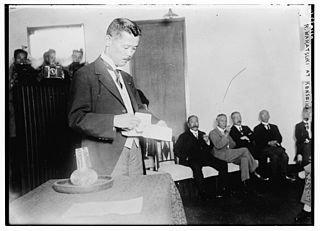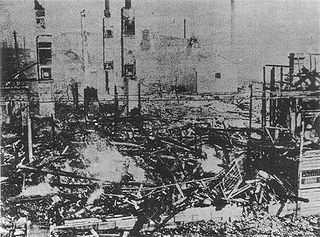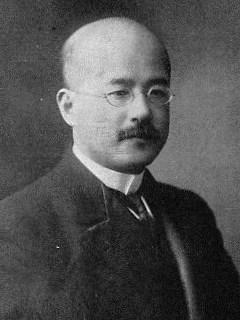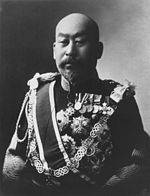
Count Hisaichi Terauchi was a Gensui in the Imperial Japanese Army, commander of the Southern Expeditionary Army Group during World War II.

Gensui Count Terauchi Masatake, GCB, was a Japanese military officer, proconsul and politician. He was a Gensui in the Imperial Japanese Army and the Prime Minister of Japan from 1916 to 1918.

Marshal-Admiral Viscount Katō Tomosaburō was a career officer in the Imperial Japanese Navy, cabinet minister, and Prime Minister of Japan from 1922 to 1923.

Kuniaki Koiso was a Japanese general in the Imperial Japanese Army, Governor-General of Korea and Prime Minister of Japan from 1944 to 1945.

Taishō (大正) is a period in the history of Japan dating from 30 July 1912 to 25 December 1926, coinciding with the reign of the Emperor Taishō. The new emperor was a sickly man, which prompted the shift in political power from the old oligarchic group of elder statesmen to the Imperial Diet of Japan and the democratic parties. Thus, the era is considered the time of the liberal movement known as Taisho Democracy; it is usually distinguished from the preceding chaotic Meiji period and the following militaristic-driven first part of the Shōwa period.

The Cabinet of Japan is the executive branch of the government of Japan. It consists of the prime minister, who is appointed by the emperor after being designated by the National Diet, and up to nineteen other members, called Ministers of State. The prime minister is designated by the Diet, and the remaining ministers are appointed and dismissed by the prime minister. The Cabinet is collectively responsible to the Diet and must resign if a motion of no confidence is adopted by the Diet.

Viscount Motono Ichirō was a statesman and diplomat, active in Meiji period Japan.

The Governor-General of Chōsen was the chief administrator of the Japanese colonial government in Chōsen from 1910 to 1945.

The Kenseikai was a short-lived political party in the pre-war Empire of Japan.

The rice riots of 1918 were a series of popular disturbances that erupted throughout Japan from July to September 1918, which brought about the collapse of the Terauchi Masatake administration.

The Japanese Cemetery Park is a Japanese cemetery and park in Serangoon, Singapore. It is the largest Japanese cemetery in Southeast Asia at 29,359 square metres, consisting of 910 tombstones that contain the remains of members of the Japanese community in Singapore, including young Japanese prostitutes, civilians, soldiers and convicted war criminals executed in Changi Prison. It was gazetted as a memorial park by the Singapore government in 1987.
Modern kana usage is the present official kanazukai. Also known as new kana usage, it is derived from historical usage.

Count Hideo Kodama, was a politician, and wartime cabinet minister in the Empire of Japan. He was the eldest son of famed Russo-Japanese War general Kodama Gentarō, and his wife was the daughter of Prime Minister Terauchi Masatake.
Takeshi Terauchi, also known as Terry, was a Japanese instrumental rock guitarist. His preferred guitar was a black Mosrite with a white pickguard. His guitar sound was characterized by frenetic picking, heavy use of tremolo picking and frequent use of his guitar's vibrato arm.

Terauchi Station is a railway station in Mooka, Tochigi Prefecture, Japan, operated by the Mooka Railway.

Japan Air Lines Cargo Flight 1628 was a UFO incident that occurred on November 17, 1986, involving a Japanese Boeing 747-200F cargo aircraft. The aircraft was en route from Paris to Narita International Airport, near Tokyo, with a cargo of Beaujolais wine. On the Reykjavík to Anchorage section of the flight, at 17:11 over eastern Alaska, the crew first witnessed two unidentified objects to their left. These abruptly rose from below and closed in to escort their aircraft. Each had two rectangular arrays of what appeared to be glowing nozzles or thrusters, though their bodies remained obscured by darkness. When closest, the aircraft's cabin was lit up and the captain could feel their heat on his face. These two craft departed before a third, much larger disk-shaped object started trailing them. Anchorage Air Traffic Control requested an oncoming United Airlines flight to confirm the unidentified traffic, but when it and a military craft sighted JAL 1628 at about 17:51, no other craft could be distinguished. The sighting lasted 50 minutes and ended in the vicinity of Denali.

Nakashōji Ren was a politician and cabinet minister in the pre-war Empire of Japan.
Ken Terauchi is a Japanese diver, who specialized in springboard and platform events. He had won two bronze medals for the springboard diving at the 2006 Asian Games in Doha, Qatar, in addition to his first at the 2001 FINA World Championships in Fukuoka.
Events from the year 1916 in Taiwan, Empire of Japan.
Events from the year 1918 in Taiwan, Empire of Japan.
















